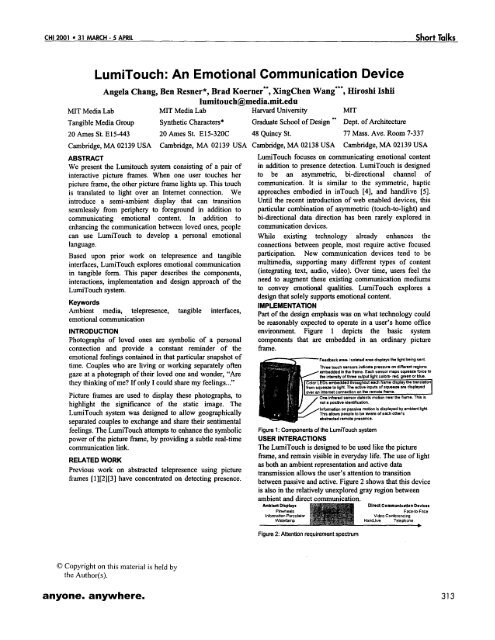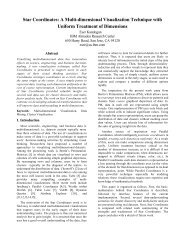LumiTouch: An Emotional Communication Device / ,den ,c ... - People
LumiTouch: An Emotional Communication Device / ,den ,c ... - People
LumiTouch: An Emotional Communication Device / ,den ,c ... - People
You also want an ePaper? Increase the reach of your titles
YUMPU automatically turns print PDFs into web optimized ePapers that Google loves.
CHI 2001 * 31 MARCH - 5 APRIL Short Talks<br />
MIT Media Lab<br />
<strong>LumiTouch</strong>: <strong>An</strong> <strong>Emotional</strong> <strong>Communication</strong> <strong>Device</strong><br />
Tangible Media Group<br />
20 Ames St. E15-443<br />
<strong>An</strong>gela Chang, Ben Resner*, Brad Koerner**, XingChen Wang***, Hiroshi Ishii<br />
Cambridge, MA 02139 USA<br />
lumitouch@media.mit.edu<br />
MIT Media Lab Harvard University<br />
ABSTRACT<br />
We present the Lumitouch system consisting of a pair of<br />
interactive picture frames. When one user touches her<br />
picture frame, the other picture frame lights up. This touch<br />
is translated to light over an Intemet connection. We<br />
introduce a semi-ambient display that can transition<br />
seamlessly from periphery to foreground in addition to<br />
communicating emotional content. In addition to<br />
enhancing the communication between loved ones, people<br />
can use <strong>LumiTouch</strong> to develop a personal emotional<br />
language.<br />
Synthetic Characters* Graduate School of Design "*<br />
20 Ames St. E15-320C 48 Quincy St.<br />
Based upon prior work on telepresence and tangible<br />
interfaces, <strong>LumiTouch</strong> explores emotional communication<br />
in tangible form. This paper describes the components,<br />
interactions, implementation and design approach of the<br />
<strong>LumiTouch</strong> system.<br />
Keywords<br />
Ambient media, telepresence, tangible interfaces,<br />
emotional communication<br />
INTRODUCTION<br />
Photographs of loved ones are symbolic of a personal<br />
connection and provide a constant reminder of the<br />
emotional feelings contained in that particular snapshot of<br />
time. Couples who are living or working separately often<br />
gaze at a photograph of their loved one and wonder, "Are<br />
they thinking of me? If only I could share my feelings..."<br />
Picture frames are used to display these photographs, to<br />
highlight the significance of the static image. The<br />
<strong>LumiTouch</strong> system was designed to allow geographically<br />
separated couples to exchange and share their sentimental<br />
feelings. The <strong>LumiTouch</strong> attempts to enhance the symbolic<br />
power of the picture frame, by providing a subtle real-time<br />
communication link.<br />
RELATED WORK<br />
Previous work on abstracted telepresence using picture<br />
frames [1][2][3] have concentrated on detecting presence.<br />
© Copyright on this material is held by<br />
the Author(s).<br />
Cambridge, MA 02139 USA Cambridge, MA 02138 USA<br />
MIT<br />
Dept. of Architecture<br />
77 Mass. Ave. Room 7-337<br />
Cambridge, MA 02139 USA<br />
<strong>LumiTouch</strong> focuses on communicating emotional content<br />
in addition to presence detection. <strong>LumiTouch</strong> is designed<br />
to be an asymmetric, hi-directional channel of<br />
communication. It is similar to the symmetric, haptic<br />
approaches embodied in inTouch [4], and handJive [5].<br />
Until the recent introduction of web enabled devices, this<br />
particular combination of asymmetric (touch-to-light) and<br />
bi-directional data direction has been rarely explored in<br />
communication devices.<br />
While existing technology already enhances the<br />
connections between people, most require active focused<br />
participation. New communication devices tend to be<br />
multimedia, supporting many different types of content<br />
(integrating text, audio, video). Over time, users feel the<br />
need to augment these existing communication mediums<br />
to convey emotional qualities. <strong>LumiTouch</strong> explores a<br />
design that solely supports emotional content.<br />
IMPLEMENTATION<br />
Part of the design emphasis was on what technology could<br />
be reasonably expected to operate in a user's home office<br />
environment. Figure 1 depicts the basic system<br />
components that are embedded in an ordinary picture<br />
frame.<br />
~ l ~ o m Feedback area- Isolated area displays the light being sent.<br />
Three touch sensors indicate pressure on different regions<br />
embedded in tim frame. Each sensor maps squeeze force to<br />
the intensity of three output light colors- red, green or blue.<br />
EDs embedded throughout each flame display the translation<br />
ueeze to light. The active inputs of squeeze are displayed I<br />
Interact connection on the remote frame. I<br />
One infrared sensor detects motion near the frame. This is<br />
/ ,<strong>den</strong> ,c. oo<br />
f jlnforma~on on passive motion is displayed by ambient light.<br />
This allows people to be aware of eaoh other's<br />
~ r abstracted remote presence.<br />
Figure 1: Components of the <strong>LumiTouch</strong> system<br />
USER INTERACTIONS<br />
The LurniTouch is designed to be used like the picture<br />
frame, and remain visible in everyday life. The use of light<br />
as both an ambient representation and active data<br />
transmission allows the user's attention to transition<br />
between passive and active. Figure 2 shows that this device<br />
is also in the relatively unexplored gray region between<br />
ambient and direct communication.<br />
Ambient Displays ~ Direct Cemmunlcztlon Devlcos<br />
Pinwheels ~ Face-to-Face<br />
Infonrnatio n Percolator Video Con~rencing<br />
Waterlamp HandJive Telephone<br />
Figure 2: Attention requirement spectrum<br />
anyone, anywhere. 3] 3
Short Talks CHI 2001 • 31 MARCH- 5 APRIL<br />
Figure 3: (Clockwise) A <strong>LumiTouch</strong> when off, a user working with<br />
<strong>LumiTouch</strong> in passive mode, the feedback panel on top lights up when<br />
sending a message, the display lights up when receiving a message, a<br />
user interacting with <strong>LumiTouch</strong>.<br />
Passive <strong>Communication</strong><br />
When a user is in front of her <strong>LumiTouch</strong>, the<br />
corresponding <strong>LumiTouch</strong> will emit an ambient glow to<br />
indicate her remote presence. This additional background<br />
information helps people figure out if there is a recipient<br />
on the other end, or also if it is a convenient time to<br />
increase interaction levels (e.g. start active communication<br />
mode or use an alternative, like a phone).<br />
Active <strong>Communication</strong><br />
When a user picks up the picture frame and squeezes, the<br />
feedback display area illuminates to show that the picture<br />
frame has been squeezed. The display colors are<br />
transmitted over the Internet to the corresponding remote<br />
<strong>LumiTouch</strong>. The display varies depending on the squeeze<br />
attributes (where, how hard, and how long the user<br />
squeezed). While the recipient party can simply enjoy this<br />
display, s/he has the option to pick up the frame and<br />
squeeze back a response to the first user, and begin an<br />
interactive exchange.<br />
Interpersonal Language<br />
The system was intended to allow users to develop an<br />
abstract form of emotional language. <strong>People</strong> could<br />
communicate in real-time by sending each other color<br />
mixtures and light patterns. The combination of colors and<br />
force allowed a grammar, while the duration of squeeze<br />
provided syntax for creative interpersonal dialect between<br />
two people.<br />
PRELIMINARY OBSERVATIONS<br />
Preliminary testing was done with users who were not<br />
emotionally involved with each other. Figure 3 illustrates<br />
some user interactions. More than one user noted that they<br />
would find having a personal <strong>LumiTouch</strong> useful.<br />
The generation of an abstracted language was observed in<br />
many cases. Users created different combinations of light<br />
intensities, colors, and pulses and agreed with each other<br />
upon private meanings to their interaction. One user used<br />
a pulsing green and blue series to communicate "good<br />
luck". A flashing red meant, "Good bye, I'm busy now?'<br />
<strong>An</strong> observer commented that they would like to give<br />
<strong>LumiTouch</strong> to a sibling who is currently in the hospital.<br />
<strong>People</strong> who are unable to actively communicate figr long<br />
periods of time (e.g. sick or elderly) might be able to use<br />
the passive transmission of <strong>LumiTouch</strong>. Similarly users<br />
who lack the required dexterity or concentration for<br />
pushing numerous buttons might appreciate this system<br />
due to its small number of simple grasping inputs.<br />
<strong>An</strong>other observer noted that a potential problem might<br />
arise from the asymmetry of participation. One person is in<br />
active interaction while the other person passively<br />
perceives ambient data. The transmitting person :may be<br />
anxious and expect that the receiver respond. However, if<br />
someone is so anxious that they feel the need to<br />
communicate immediately, they can just use the phone, or<br />
other higher-bandwidth alternative.<br />
CONCLUSION AND FUTURE WORK<br />
In closing, we have described our design of an emotional<br />
communication device that can transition between passive<br />
and active mode seamlessly. We have also outlined some<br />
preliminary observations of the usability of <strong>LumiTouch</strong>. It<br />
appears the dual level of attention this device supports<br />
appeals to people. Eventually we hope <strong>LumiTouch</strong> will aid<br />
in explorations of the development of interpersonal<br />
emotional language. We hope to gather more data by<br />
adding support for the manipulation of real-time data to<br />
the <strong>LumiTouch</strong>. Users could record and replay the touch<br />
history, like a voice mail message. Maybe the history of<br />
touch "conversations" and patterns can be documented.<br />
ACKNOWLEDGMENTS<br />
We thank MIT Media Lab for their support on this project.<br />
We also thank our loved ones for their inspiration.<br />
REFERENCES<br />
1. Tollmar, K., Junestrand, S., and Torgny, O., Virtually<br />
Living Together.DIS'O0 (Brooklyn NY, August 2000),<br />
ACM Press, 83-91.<br />
2. Strong, R., and W. Gaver. Feather, Scent, and Shaker:<br />
Supporting Simple Intimacy. Proceedings of CSCW '96<br />
(Boston MA, November 1996), ACM Press, 29-30.<br />
3. Dodge, C. The Bed: A Medium for Intimate<br />
<strong>Communication</strong>. Extended Abstracts of CHI'97, ACM<br />
Press, 371-372.<br />
4. Brave, S. and Dahley, A., inTouch: A Medium for<br />
Haptic Interpersonal <strong>Communication</strong>, £~tended<br />
Abstracts of CHl "97, ACM Press, 363-364.<br />
5. Fogg, B.J, Cutler, L.D., Arnold, P. and Eisbach, C.,<br />
HandJive: a device for interpersonal haptic<br />
entertainment, CHI "98, ACM Press, 57-64.<br />
314 CH12001









